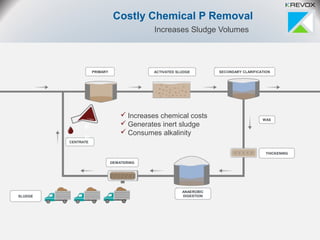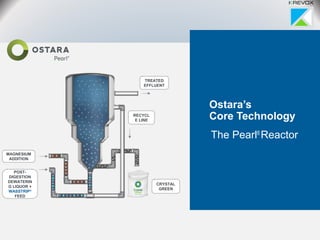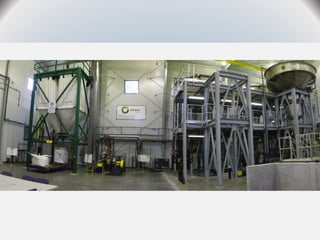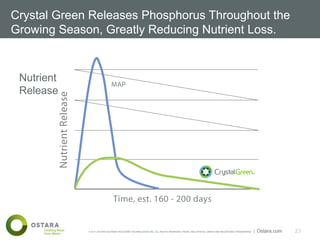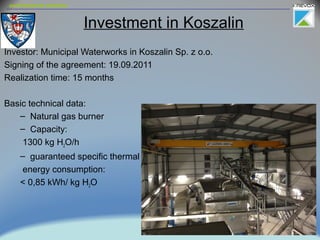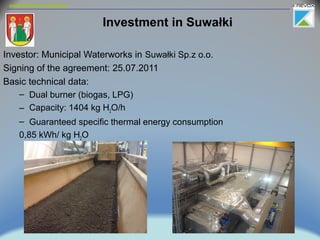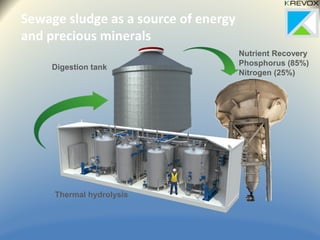Ostara
- 1. Smart solutions at advanced sewage sludge treatment plant. Lviv, 07.10.2016 Aleksander Suszyński, PhD Eng.
- 3. PERFECT SOLUTION – OPTYMALNE ROZWIĄZANIE 3
- 4. Phosphourous recovery (up to 90 %) and Nitrogen (up to 25 %) from recirculated load of nutrients Example: WWTP capacity of 60 000 – 90 000 m3 /d Production of fertilizer 250 – 450 t/year Savings in range of 550 000 – 850 000 €/year* *Polish conditions. Digestion chamber OSTARA Process - Pearl
- 5. The Phosphorus Cycle Today Is Broken
- 6. Phosphorus Reserves are Limited Highly Concentrated, Finite Supply
- 7. Ostara’s Solution Closes the Loop Transforming Treatment Plants to Resource Recovery Facilities
- 8. Ostara’s Growing Installation Base 2005 Year Ostara was founded 40 Number of employees including: Research, Operations, Fertilizer Sales 14 Number of commercial installations worldwide 5 Number of countries with deployed Ostara solutions Technology recently implemented in Madrid by Veolia In Poland there have been conducted already pilot tests in Warsaw, Poznań, Gdynia, Jarocin, at the moment pilot tests are conducted in Rzeszow
- 9. Accidental Struvite Formation Poses Serious Operational Challenges Mg2+ + NH4 + + PO4 3- NH4 Mg PO4 ∙ 6H2O
- 10. Accidental Struvite Formation Also Occurs in Anaerobic Digesters and Dewatering Equipment
- 11. Solution: Recovering and Getting Premium Quality, Slow Release Fertilizer
- 12. Nuisance Struvite BNR Can Create Operational Challenges ANAEROBIC DIGESTION THICKENING PRIMARY ACTIVATED SLUDGE SECONDARY CLARIFICATION DEWATERING SLUDGE CENTRATE 20-25% of influent loading
- 13. Costly Chemical P Removal Increases Sludge Volumes SLUDGE ANAEROBIC DIGESTION CENTRATE THICKENING PRIMARY ACTIVATED SLUDGE SECONDARY CLARIFICATION WAS DEWATERING F e Increases chemical costs Generates inert sludge Consumes alkalinity
- 14. Pearl® + WASSTRIP® Solve Operational Challenges while Maximizing P Available for Recovery WASSTRIP® Alleviates struvite in digester PEARL® Recovers high value fertilizer ANAEROBIC DIGESTION BIOSOLIDS THICKENING PRIMARY ACTIVATED SLUDGE SECONDARY CLARIFICATION DEWATERING
- 15. Ostara’s Core Technology The Pearl® Reactor TREATED EFFLUENT RECYCL E LINE MAGNESIUM ADDITION POST- DIGESTION DEWATERIN G LIQUOR + WASSTRIP® FEED CRYSTAL GREEN
- 16. Flow sheet – OSTARA Process MAGNESIUM ADDITION PEARL DEWATERING CLASSIFYING FEED DRYING BAGGING Product is dried and bagged on site, ready for market
- 18. © 2016 Ostara Nutrient Recovery Technologies Pearl® 500 9.5 m Load Capacity (PO4-d) 65 kg Production Rate (CG/d) 500 kg Installation Base (2016) 8/8 65 kg Production Rate (CG/d) 500 kg Installation Base (2016) 8
- 19. © 2016 Ostara Nutrient Recovery Technologies Pearl® 2K Production Rate (CG/d) 2000 kg Installation Base (2016) 12 11 m Production Rate (CG/d) Installation Base (2016) 3.2 m
- 20. © 2016 Ostara Nutrient Recovery Technologies Pearl® 10K Load Capacity (PO4-d) 1260 kg Production Rate (CG/d) 10000 kg Installation Base (2016) 1/1 16 m Production Rate (CG/d) 10,000 kg Installation Base (2016) 4 7.3 m
- 21. CrystalGreen NP(Mg) 5-28-(10) 5% - NItrogen (NH4) 28% - Phosphour (P2O5) 10% - Magnesium (Mg)
- 22. Why We Recover a Specific Saleable Size Four Blend-Ready Sizes SGN 90 SGN 150 SGN 300 SGN 450 TURF & ORNAMENTAL AGRICULTURE HORTICULTURE
- 23. 23© 2011 OSTARA NUTRIENT RECOVERY TECHNOLOGIES INC. ALL RIGHTS RESERVED. PEARL AND CRYSTAL GREEN ARE REGISTERED TRADEMARKS. | Ostara.com Crystal Green Releases Phosphorus Throughout the Growing Season, Greatly Reducing Nutrient Loss. Nutrient Release
- 24. Main advantages of OSTARA Process implementation: 1.Reduction of secondary load of nutrients at WWTP – up to 90 % of P and 25 % N. 2.Limitation of struvite generation in digestion chambers and other equipment. 3.Decraese of sewage sludge being generated up to 25 %. 4.Better dewatering performacne up to 4 % DS. more 5.Minimalisation or lack of dosing chemicals for Phosphourous precipitation reason. 6.Production of valuable fertilizer.
- 25. Thermal drying of sewage sludge
- 26. 26 Sludge Drying Dewatered Sludge Dried Granules • 18 - 35% DS • Sticky • Caloric heating value < 1 MJ/kg • biologically active ( digestion processes ) • > 90% DS • free flowing • Caloric heating value - 8 - 11 MJ/kg (digested) - > 12 MJ/kg ( non- digested ) • pathogen free • biologically stable by from Waste to Product Transfer of the dewatered sludge Why Drying??
- 27. environmental solutions Dewatered sludge 20-30% DS Dried sludge 90%DS How attractive is dried sludge as a potential alternative fuel If we dry up to 90 % DS. sludge with 65 % organic LCV > 13 MJ/kg of granulate
- 28. environmental solutions Thermal sewage sludge dryers in PolandThermal sewage sludge dryers in Poland 28 Siedlce Płock Płońsk Ozimek Końskie Wieruszów Chełm Olkusz Siedlce Płock Ciechanów Szczecin („Zdroje”) Poznań Włocławek Grudziądz Białystok Warszawa („Południe”)Grodzisk Mazowiecki Piaseczno Lublin Radom Częstochowa Ruda Śląska Rzeszów Świdnica Thermal dryers Tarnów Opole Kędzierzyn-Koźle Wrocław Thermal dryers in perspective Toruń Koszalin Suwałki Żywiec Stalowa Wola Ciechanów Tomaszów Mazowiecki Puławy Płock SiedlcePruszków Żyrardów Kozienice Myszków Skarżysko-Kamienna Bełchatów Płońsk Wieruszów Bytom At the moment in PolandAt the moment in Poland there are 33 thermal sewagethere are 33 thermal sewage sludge municipal dryers, nextsludge municipal dryers, next 30 are in perspective…30 are in perspective… Legnica Kraśnik Łowicz Lubartów Białobrzegi 4 of them are using heat4 of them are using heat generated in sewage sludgegenerated in sewage sludge mono incineration plantsmono incineration plants All other uses in practice onlyAll other uses in practice only natural gasnatural gas At majority of drying plantsAt majority of drying plants big technical problemsbig technical problems occured that some of foreignoccured that some of foreign manufaturers had to resignmanufaturers had to resign from presence at polishfrom presence at polish marketmarket
- 29. environmental solutions Diagram of complex managaement of sewage sludge using waste heat Power plant Waste heat Thermal drying Valuable alternative fuel – Dried sludge> 90 % s.m. LCV a. 12 – 14 MJ/kg Mechanically dewatered sludge LCV a. 2 MJ/kg Steam/flue gases/thermal oil Solution in 100 % waste free from WWTP Point of view Dried sludge is seen as CO2 neutral fuel Possibility of acquiring sludge from different plants Optimal solution for WWTP located nearby Power Palnts Operation costs are reduced by 50 – 70 % in comparison to standard solution
- 30. environmental solutions RADOM 3150 kg H2O/h KOSZALIN 1300 kg H2O/h SUWAŁKI 1404 kg H2O/h TORUŃ 2600 kg H2O/h REALIZED THERMAL DRYERS IN POLAND BY KREVOX ŻYRARDÓW 750 kg H2O/h
- 31. environmental solutions Investor: Municipal Waterworks in Radom Sp. z o.o. Start of the realization: 04.2007 Basic technical data: •1 proces line of the belt drying system –direct drying, –Dual burner (natural gas, oil), –capacity: 3150 kg H2O/h, –Guaranteed specific thermal energy consumption 0,9 kWh/ kg H2O. Investment in Radom
- 32. environmental solutions Investment in Torun Basic technical data: –Triple burner (natural gas, biogas, oil), –capacity: 2600 kg H2O/h, –guaranteed specific thermal energy consumption 0,85 kWh/ kg H2O.
- 33. environmental solutions Investment in Koszalin Investor: Municipal Waterworks in Koszalin Sp. z o.o. Signing of the agreement: 19.09.2011 Realization time: 15 months Basic technical data: – Natural gas burner – Capacity: 1300 kg H2O/h – guaranteed specific thermal energy consumption: < 0,85 kWh/ kg H2O
- 34. environmental solutions Investment in Suwałki Investor: Municipal Waterworks in Suwałki Sp.z o.o. Signing of the agreement: 25.07.2011 Basic technical data: – Dual burner (biogas, LPG) – Capacity: 1404 kg H2O/h – Guaranteed specific thermal energy consumption 0,85 kWh/ kg H2O
- 35. environmental solutions Investment in Żyrardów Investor: Municipal Waterworks in Żyrardów Sp. z o.o. – Dual burner (biogas, natural gas) – Capacity: 742 kg H2O/h – Amount of mechanically dewatered sludge: 948 kg/h for 20 % DS – Guaranteed specific thermal energy consumption: 0,85 kWh/kg H2O – Guaranteed specific electrical energy consumption: 0,1 kWh/kg H2O
- 36. environmental solutions Phosphourous recovery (up to 85 %) and Nitrogen (up to 25 %) from recirculated load of nutrients Example: WWTP capacity of 60 000 – 90 000 m3 /d Production of fertilizer 250 – 450 t/year Savings in range of 550 000 – 850 000 €/year* *Polish conditions. Digestion chamber OSTARA Process - Pearl
- 37. Radial blowers
- 38. environmental solutions THANK YOU for Your attention Lviv, 07.10.2016 Aleksander Suszyński, PhD Eng. aleksander.suszynski@krevox.com
- 39. Sewage sludge as a source of energy and precious minerals Nutrient Recovery Phosphorus (85%) Nitrogen (25%) Digestion tank Thermal hydrolysis
Editor's Notes
- The phosphorus cycle today is unsustainable. Phosphate rock is mined from stores in select places of our globe. Phosphorus fertilizer refining creates phosphate hazardous waste. Fertilizer is used to feed crops and livestock, runoff, leaching. Without phosphorus treatment, treatment plants discharge P to the surface waters. All this phosphorus in our surface water has resulted in environmental impacts such as dead zones and eutrophication of our waterways. The EPA estimates that more than 15,000 bodies of water have nutrient impairments including highly used recreational areas such as the Chesapeake Bay, Lake Erie, and (insert local place) right in your backyard. And why do we do what we do? The phosphorus cycle today is broken, in every sense Globally we are facing a nutrient crisis With deadzones the size of the state of Georgia (95,000 miles) due to nutrient pollution from both point and non-point sources and unsustainable supply and demand of this very valuable nutrient And this is how Ostara solves this problem.
- MAP SOURCE: http://anz.ipni.net/article/ANZ-3186, Source, USGS Mineral Commodity Summaries, http://minerals.usgs.gov/minerals/pubs/commodity/phosphate_rock/index.html#mcs) Although the stocks of rock phosphate, the main source of mineral P fertilizers, are difficult to assess, there is a growing concern that mines might be depleted within a century Morocco listed as 50000 BMT (billion metric tonnes), source: http://pdf.usaid.gov/pdf_docs/Pnadw835.PDF
- Ostara recovers P from nutrient rich waters allowing discharge criteria to be met while producing a high value fertilizer We help treatment plants meet their discharge limits by recovering P. Our fertilizer production process is significantly more sustainable than that used for traditional P fertilizers. And Crystal Green, our fertilizer product, is the most sustainable P fertilizer available because it is only available to plants when they need phosphorus.
- It is nice to talk about what we do, but it is nice to talk about where we have done it.
- Pima County – 33-calowa rura zwęziła się do 1-cala w ciągu 2 tygodni. HRSD – rura zwęziła się od 8-cali do 1-cala w ciągu 6 tygodni. Problem jest zazwyczaj rozwiązywany przez dodanie chlorku żelaza (co uniemożliwia biologiczne wykorzystanie P)
- Wytrącanie struwitu w komorach fermentacyjnych
- Nuisance struvite is a challenge for treatment plants. It can form in digesters where the presence of ammonia from the digestion process combined with dissolved ortho-p and magnesium forms struvite. We also see this accidental struvite forming in centrate lines and as part of added biosolids volume.
- Treatment plants could choose to use chemicals to remove phosphorus. Here you see a treatment plant schematic showing a conventional treatment process including primary treatment, activated sludge, and secondary clarification where chemicals are being used for phosphorus removal. Using metal salts like alum and ferric chloride is expensive and creates large amounts of biosolids. There is a better way to remove phosphorus.
- WASSTRIP and Pearl work together as part of the treatment plant process to recover phosphorus as a high-value fertilizer. WASSTRIP intercepts the WAS upstream of thickening. After thickening the filtrate is sent to Pearl. This filtrate is high in dissolved P and magnesium, but low in ammonia. The Thickened sludge goes to digestion where methanogens break down the carbon and create ammonia and methane gas in the process. After dewatering, centrate or other dewatering liquor that is high in ammonia is also routed to Pearl. These two influent streams combine to create the perfect environment for the formation of prills. There are numerous benefits to using this process. Let’s walk through them now.
- We have talked about Ostara’s recovery solution which is a combination of Pearl and Wasstrip. This picture shows a schematic of what is happening in the pearl reactor. You have nutrient rich influent and wasstrip feed that comes into the bottom of the fluidized bed upflow reactor. Chemicals are added to create ideal reaction conditions with supersaturated magnesium at the proper pH. Reactor contents are recycled and treated effluent flows from the top of the reactor. Periodically an operator will start a harvest cycle to harvest Crystal Green.
- We then heat treat, dry, classify and bag the market ready product in a fully-automated system. Our process not only creates a highly clean and pure end product; it creates a product that is ready for sale.
- Load: 65 kgs Production: 500 tonnes
- Metric sizes underneath
- Load: 1260 kgs Production: 10000 tonnes
- Horticulture picture
- This data comes from dissolution studies conducted in June 2012 With MAP, the P releases faster than plants can take it up. P is lost to soil and water environment and not available to the plant later in the season. As you can see, the Crystal Green releases more slowly than MAP, providing continuous feeding of P throughout the growing season and reducing the potential for P to enter the water environment. Source: Applied Chemical Technologies dissolution study conducted June 2012 This curve shows that under these conditions, CG releases nutrients more slowly than MAP (monoammonium phosphate). It also shows that the particle size of Crystal Green influences its release pattern, with smaller granule sizes releasing slightly faster and having a shorter longevity. The X-axis scale is generically labeled “time” because although these data experiment is measured in hours, the release of Crystal Green in normal field conditions is on a scale of months. Principle: A representative unground sample is exposed to a series of solvent extractions. Each extract is analyzed for the nutrient(s) of interest. Conditions are used to accelerate the release of nutrients compared to normal soil conditions. 5 grams of product is added to each column. Each extraction uses 475 mL of extraction solution (0.2% citric acid), which was circulated through the column at 50 deg C for 2-8 hours. 9 extractions total were done, but only 7 are shown on this graph because all product was released after 7 extractions.












